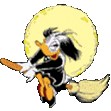Acerca dos high five do mohan
2 mensagens
|Página 1 de 1
Acerca dos high five do mohan
Verão bonitinha aqui
http://www.21stcenturyfutures.com/page/ ... ghfive.txt
The High Five
I want to share with you a unique approach to staying on the right side of the market when you are day-trading the SP500 futures, using a special synthesized indicator I've dubbed the "High Five."
The "High Five" consists of the following indicators:
the NASDAQ Composite Index (the "NAZ")
the TRIN
the VIX
the TICK index
MER (Merrill Lynch Stock)
Together, these five indicators can paint a clear picture of the market's mood and direction for that session. When they all point in the same direction, you are ill-advised to fade them, and when they give a mixed picture you can often save time and money by staying flat.
Using the High Five is a simple way of taking the pulse of the market right now, in real time. It is not the "Holy Grail," even though I've had lots of feedback from traders who think it's a miracle.
Synthesizing the High Five takes practice, and involves watching the markets closely every day, learning to read its nuances. It's not really possible to learn this in a few months, so don't expect miracles right away. But if you treat S&P500 futures trading as a serious business, success will inevitably follow as you progress in your skill development.
What you usually find with the High Five in day-to-day trading is the market getting ready to "roll over" from a bullish scenario to neutral or all the way to bearish, or vice versa. It can also tell you when a trading day is likely to be "one-way" and when you need to go ahead and sell a market that is breaking down, or buy a market that is breaking out.
The High Five is an incredibly valuable tool to help you make trading decisions during the heat of the action. All the details on interpreting the High Five are available for subscribers in Chapter 5 of my S&P 500 Trading Handbook.
Below you'll find the quick reference table for the High Five, giving you the parameters to look for as well as the definition of each indicator.
High Five: Using Indices as Indicators
Quick Reference Table
TAPE
TRIN
(actual value)
VIX
(daily change)
TICK
(actual value)
NASDAQ
(daily change)
MER
(daily change)
Mega Bullish
+0.60 or lower
-1.20 or lower
+500 to +800
+20 or more
+1.50 or more
Bullish
+0.80 or lower
-0.80 or lower
+200 to +700
+15 to +20
+1.00 or more
Mixed/Neutral
0.9 to 1.00
-0.30 to +0.60
-300 to +200
-15 to +15
+0.50 to -1.00
Bearish
+1.00 or higher
+0.80 to +1.00
-500 to -700
-15 to -20
-1.00 or more
Bear Ugly
+1.30 or higher *
+1.0 to 1.5
or higher
-500 to -700, banging on -900+
-20 or more
-1.50 or more
* TRIN becomes "overcooked" bearish and due for a reversal when the readings reach above the 1.80-2.00 level on the day AFTER a previous down day with extremely high TRIN readings. Prepare to reverse long upon seeing such readings.
NASDAQ
The Nasdaq Composite Index measures all Nasdaq domestic and non-U.S. based common stocks listed on The Nasdaq Stock Market. The Index is market-value weighted. Currently it includes more than 4,000 stocks listed with the Nasdaq and represents the broad market for the Nasdaq.
Only the daily change (change from the previous day's close) is significant as a High Five indicator.
MER
Merrill Lynch, a leading brokerage house and one of the largest, trades in the NYSE with the ticker symbol of MER.
Only the daily change (change from the previous day's close) is significant as a High Five indicator.
TICK
The TICK indicator is based on the statistic computed from the net of all UP-TICKs minus all DOWN-TICKs at a given point during the day in NYSE. If 500 stocks advanced on their last trade or TICK, 200 declined and 500 were unchanged, the TICK would be +300 (500 minus 200). The closing TICK is based on the last trade of the day. TICK statistics are available for the NYSE, Nasdaq and AMEX. The High 5 indicator complex uses only the NYSE numbers.
Actual reading as reported by the exchange is used as part of High Five.
TRIN
The TRIN (also known as ARMS Index, named after its inventor, Richard Arms) is short for TRaders INdex. It is a contrarian indicator to detect overbought and oversold levels in the market. Because of its calculation method, the TRIN has an inverse relationship with the market. Generally, a rising TRIN is bearish and a falling TRIN is bullish. The TRIN is the advance/decline ratio divided by the advance volume/decline volume ratio. The formula for calculating it is:
((Advancing issues/declining issues) / (advancing volume/declining volume))
As in the TICK, we are concerned only with the NYSE statistic.
Actual reading as reported by the exchange is used as part of High Five.
VIX
VIX stands for the CBOE Volatility Index. VIX is a weighted measure of the implied volatility for 8 OEX put and call options. Typically, VIX (and by extension implied volatility) also has an inverse relationship to the market. The value of VIX increases when the market declines and decreases when the market rises.
Only the daily change (change from the previous day's close) is significant as a High Five indicator.
http://www.21stcenturyfutures.com/page/ ... ghfive.txt
The High Five
I want to share with you a unique approach to staying on the right side of the market when you are day-trading the SP500 futures, using a special synthesized indicator I've dubbed the "High Five."
The "High Five" consists of the following indicators:
the NASDAQ Composite Index (the "NAZ")
the TRIN
the VIX
the TICK index
MER (Merrill Lynch Stock)
Together, these five indicators can paint a clear picture of the market's mood and direction for that session. When they all point in the same direction, you are ill-advised to fade them, and when they give a mixed picture you can often save time and money by staying flat.
Using the High Five is a simple way of taking the pulse of the market right now, in real time. It is not the "Holy Grail," even though I've had lots of feedback from traders who think it's a miracle.
Synthesizing the High Five takes practice, and involves watching the markets closely every day, learning to read its nuances. It's not really possible to learn this in a few months, so don't expect miracles right away. But if you treat S&P500 futures trading as a serious business, success will inevitably follow as you progress in your skill development.
What you usually find with the High Five in day-to-day trading is the market getting ready to "roll over" from a bullish scenario to neutral or all the way to bearish, or vice versa. It can also tell you when a trading day is likely to be "one-way" and when you need to go ahead and sell a market that is breaking down, or buy a market that is breaking out.
The High Five is an incredibly valuable tool to help you make trading decisions during the heat of the action. All the details on interpreting the High Five are available for subscribers in Chapter 5 of my S&P 500 Trading Handbook.
Below you'll find the quick reference table for the High Five, giving you the parameters to look for as well as the definition of each indicator.
High Five: Using Indices as Indicators
Quick Reference Table
TAPE
TRIN
(actual value)
VIX
(daily change)
TICK
(actual value)
NASDAQ
(daily change)
MER
(daily change)
Mega Bullish
+0.60 or lower
-1.20 or lower
+500 to +800
+20 or more
+1.50 or more
Bullish
+0.80 or lower
-0.80 or lower
+200 to +700
+15 to +20
+1.00 or more
Mixed/Neutral
0.9 to 1.00
-0.30 to +0.60
-300 to +200
-15 to +15
+0.50 to -1.00
Bearish
+1.00 or higher
+0.80 to +1.00
-500 to -700
-15 to -20
-1.00 or more
Bear Ugly
+1.30 or higher *
+1.0 to 1.5
or higher
-500 to -700, banging on -900+
-20 or more
-1.50 or more
* TRIN becomes "overcooked" bearish and due for a reversal when the readings reach above the 1.80-2.00 level on the day AFTER a previous down day with extremely high TRIN readings. Prepare to reverse long upon seeing such readings.
NASDAQ
The Nasdaq Composite Index measures all Nasdaq domestic and non-U.S. based common stocks listed on The Nasdaq Stock Market. The Index is market-value weighted. Currently it includes more than 4,000 stocks listed with the Nasdaq and represents the broad market for the Nasdaq.
Only the daily change (change from the previous day's close) is significant as a High Five indicator.
MER
Merrill Lynch, a leading brokerage house and one of the largest, trades in the NYSE with the ticker symbol of MER.
Only the daily change (change from the previous day's close) is significant as a High Five indicator.
TICK
The TICK indicator is based on the statistic computed from the net of all UP-TICKs minus all DOWN-TICKs at a given point during the day in NYSE. If 500 stocks advanced on their last trade or TICK, 200 declined and 500 were unchanged, the TICK would be +300 (500 minus 200). The closing TICK is based on the last trade of the day. TICK statistics are available for the NYSE, Nasdaq and AMEX. The High 5 indicator complex uses only the NYSE numbers.
Actual reading as reported by the exchange is used as part of High Five.
TRIN
The TRIN (also known as ARMS Index, named after its inventor, Richard Arms) is short for TRaders INdex. It is a contrarian indicator to detect overbought and oversold levels in the market. Because of its calculation method, the TRIN has an inverse relationship with the market. Generally, a rising TRIN is bearish and a falling TRIN is bullish. The TRIN is the advance/decline ratio divided by the advance volume/decline volume ratio. The formula for calculating it is:
((Advancing issues/declining issues) / (advancing volume/declining volume))
As in the TICK, we are concerned only with the NYSE statistic.
Actual reading as reported by the exchange is used as part of High Five.
VIX
VIX stands for the CBOE Volatility Index. VIX is a weighted measure of the implied volatility for 8 OEX put and call options. Typically, VIX (and by extension implied volatility) also has an inverse relationship to the market. The value of VIX increases when the market declines and decreases when the market rises.
Only the daily change (change from the previous day's close) is significant as a High Five indicator.
2 mensagens
|Página 1 de 1



